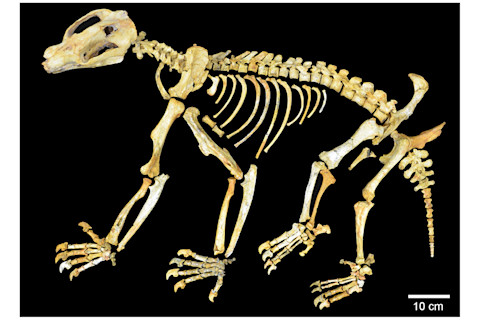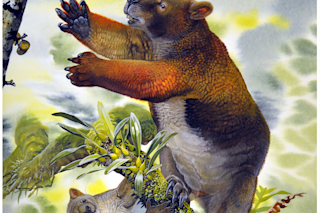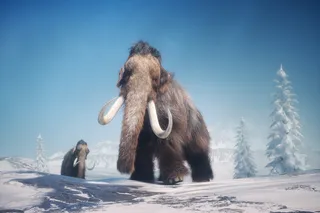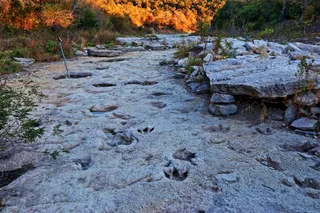We can’t know what Nimbadon looked like for sure, but the fossil record provides us some clues. It shows us that it was likely a curious-looking creature. Weighing in at a whopping 150 pounds, Nimbadon was about five times as large as a koala, a sloth-like figure with oversized claws, sizable hands and feet, and strong arms meant for clinging to the canopy.
The species was a type of diprotodontoids to which wombats and koalas are closely related. The similarities between koalas and Nimbadon are striking. They both depended on the forest, and they were both built to hang from the trees that they called home.
A prolific collection of fossils found in Queensland, Australia, paints a picture of a species shaped by a geology that no longer exists today on the continent.
Nimbadon: The Giant Koala of the Miocene

Nimbadon lavarackorum (Diprotodontidae) a heavyweight marsupial herbivore in the Miocene forests of Australia. (Credit: PLOS ONE)
PLOS ONE
In a study published in the May 2023 edition of the Journal of Paleontology, researchers found that Nimbadon’s semi-opposable thumbs meant the species was at home high in the treetops. It likely lived like a giant koala with claws to hold onto trees and shorter hind limbs that allowed it to suspend in midair.
What Did the Giant Koala Eat?
In short, Nimbadon was built like a tree hugger, anatomically meant for hanging from the foliage that provided its habitat and its food. According to the same Journal of Paleontology study, its teeth show that it was a browser that may have eaten fruit when it was available, depending on seasonality. When fruit was out of season, the species feasted on other forms of vegetation found in the forest.
When Did the Giant Koala Exist?
Living in the middle Miocene, around 15 million years ago, the giant koala thrived during a time when Australia would have been blanketed in lush rainforests. Its habitat would have presented ample opportunity for it to be camouflaged.
Hiding would have been essential as it lived alongside apex predators like flesh-eating kangaroos, giant Cleaver-headed crocodiles, and the marsupial lion, an ambush predator with slicing teeth and a giant thumb claw perfect for disemboweling its prey.
Read More: What Animals Are Going Extinct?
Nimbadon’s Role in the Forest
When Nimbadon lived, it was likely a widely dispersed mammal, found commonly across Australia and New Guinea, according to a study published in the November 2012 edition of the journal PLOS ONE.
The study found that diprotodontoids, previously thought to be herding and grazing animals like sheep or rhinoceros, likely felt more at home in the forest. The species may have played a role similar to what tapirs and monkeys play today, as a fruit eater and large seed disperser that helped the forest thrive.
But Nimbadon’s dependence on the forest may also have been what did it in. Although scientists aren’t yet sure, there is some thought that such a large species would have required so much food that a diminishing forest could no longer support it.
Read More: 5 Ancient Animals That Stood The Test Of Time
When Did the Giant Koala Go Extinct?
According to an October 2018 study published in the journal Nature, the marsupial lion, who depended on the forest to ambush its prey, likely went extinct because of climate change, and Nimbadon might have faced the same end.
Nimbadon likely went extinct around 11,000 years ago at a time when Australian megafauna were disappearing at a rapid rate. Other large species like Diprotodon, a giant wombat, and Megalania, the largest terrestrial lizard ever, were also disappearing.
Bigger is not always better, especially as Australia began to dry up and much of the continent was replaced by desert. Many of the species that had thrived before began to die out, and the giants of yesteryear, like Nimbadon, the marsupial lion, and the killer Kangaroo known as Ekaltadeta, also saw their way to the door.
Read More: Scientists Might Bring Back These Extinct Animals















